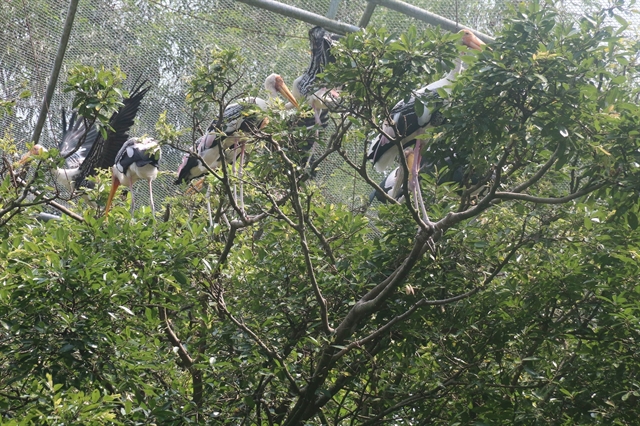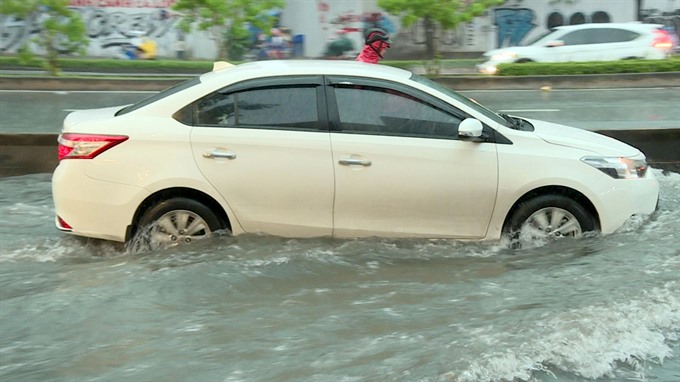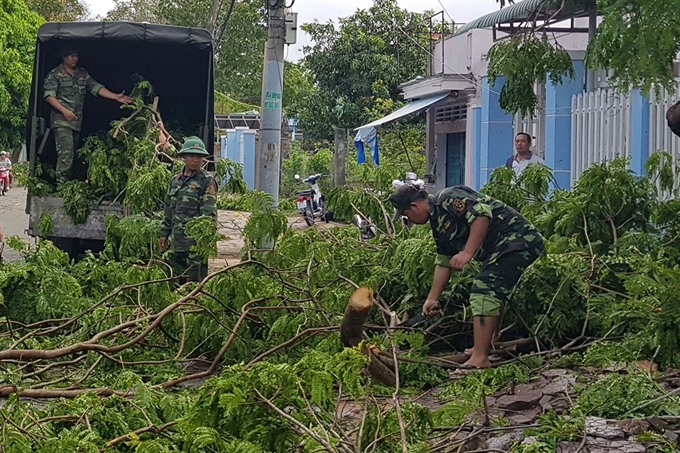 Environment
Environment

Typhoon Usagi, which weakened into a tropical depression over the weekend, hit HCM City hard on Sunday, damaging electrical cables, stranding cars on streets, and flooding basements.
 |
| Thousands of cars were stranded on streets after HCM City experienced its highest-ever rainfall within a 24-hour period. VNA/VNS Photo Ngọc Diệp |
HCM CITY — Typhoon Usagi, which weakened into a tropical depression over the weekend, hit HCM City hard on Sunday, damaging electrical cables, stranding cars on streets, and flooding basements.
Authorities in HCM City and the neighbouring provinces of Bình Dương, Long An, and Bà Rịa-Vũng Tàu on Sunday began cleaning up streets, repairing damage, and pumping water out of schools and basements.
The Southern Power Corporation of the Electricity of Việt Nam (EVN SPC) on Sunday directed all of its units to immediately repair all power stations and lines damaged by the typhoon.
By Monday, the city’s electricity system had resumed operation, according to EVN SPC.
In the health sector, Dr Nguyễn Trí Dũng, director of the city’s Preventive Medicine Center, said that all district-level health centres had been asked to be on the alert for potential outbreaks of disease.
“Storm No 9 weakened but heavy rain and flooding could occur again. It’s the perfect environment for dengue fever, hand-foot-mouth disease and measles,” Dũng said.
The centre asked all 24 districts to provide information about preventive measures to raise awareness in the community about these diseases.
People should wash their hands regularly with soap and water, disinfect their homes, schools and public playgrounds, and get measles vaccinations, he said.
Local agencies have been asked to closely monitor schools and take steps to prevent the spread of dengue fever.
During the storm, thousands of cars were stranded on flooded streets because their engines had died.
A representative of Bảo Việt Insurance said that owners of cars with damaged engines might have to pay tens of million of đồng, even hundreds of million of đồng, to repair their cars, depending on the type of insurance they have.
A representative of Liberty Insurance said that cars with damaged engines could cost up to billions of đồng to repair. Not all cases will be covered by insurance.
The city’s Fire Fighting and Prevention Police Department has been helping pump water out of buildings with flooded basements, such as the Ngọc Khánh Apartment building in District 5 and more than 10 building basements on Phan Xích Long Street in Phú Nhuận District.
On Monday, students did not attend school in HCM City, but teachers and others helped pump water out of their schools to prepare for the next day.
The highest-ever rainfall within 24 hours in HCM City on Sunday (Nov 25) flooded about 102 spots in the city.
On Monday, some places such as Đinh Bộ Lĩnh Street in Bình Thạnh District were still flooded and vehicles could not move on the streets.
The same situation occurred on National Highway 13, a section of Bình Triệu Bridge that extends to Hàng Xanh intersection, the An Lac traffic circle, Phan Huy Ích Street in Tân Bình District and the Quốc Hương Street in District 2. As of Monday at 5 pm, they were still flooded.
Nguyễn Hoàng Anh Dũng, deputy director of the city’s Steering Centre for Flood Control, said nearly 700 workers had cleared rubbish stuck in sewers.
The centre also used 27 pumps to drain water on Sunday, but the city’s drainage system could not handle all of the water, Dũng said.
To prevent loss of life and property, reservoirs and other water supply and sewage systems would operate at full capacity, he said.
 |
| Authorities in HCM City and the neighbouring provinces of Bình Dương, Long An, and Bà Rịa-Vũng Tàu on Sunday began cleaning up streets, repairing damage, and pumping water out of schools and basements. Photo Hòang Hải |
Unprepared for deluge
Nguyễn Văn Trực, deputy director of the city’s Department of Agriculture and Rural Development, said the city’s flood prevention plans had plans for only a maximum of 200mm of rainfall. At least 400 mm fell on HCM City within 24 hours.
Vũ Hải, a former lecturer at the Technology and Civil Engineering universities in Hà Nội, said the city’s investments in flood prevention were significant, but that planning was poor and inadequate, and did not fit reality.
Three years ago, the city planned to build 103 anti-flood reservoirs around the city, but none of them have been built.
The National Center for Hydro-Meteorological Forecasting said that Storm No 9 was the ninth storm to hit Việt Nam this year, and several more may occur before the end of the year.
The storm was predicted to strike Khánh Hòa and Ninh Thuận provinces, but it weakened when it made landfall.
It changed direction and headed toward HCM City and neighboring provinces.
The National Center for Hydro-Meteorological Forecasting had predicted that the typhoon would result in 200-220mm of rain. But it actually totalled 300-400mm, depending on the area.
Nhà Bè District recorded 345mm, the city centre received 301mm, and Cần Giờ on the coast 293mm. Tân Bình District recorded a staggering 407.6mm.
Lê Đình Quyết, deputy director of the forecasting department at the Southern Centre for Hydro-Meteorological Forecasting, said it was highest-ever rainfall recorded in HCM City within a 24-hour period. — VNS